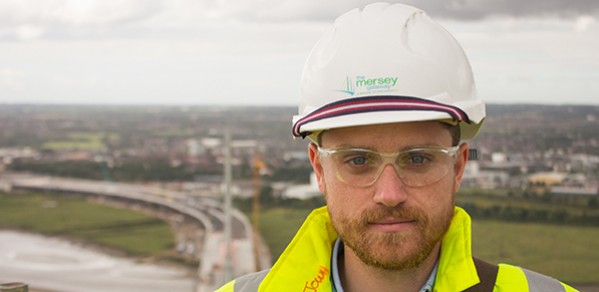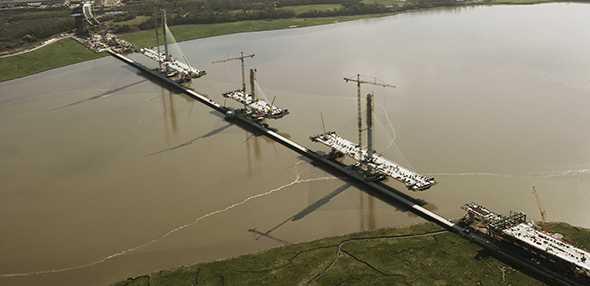
Johannes Whittam will never forget the hands-on construction experience he gained while at Cambridge. Now he’s a Senior Engineer working on one of the biggest bridge projects in the UK.
I think the Constructionarium project is really valuable for anyone going on to work as a civil or structural engineer. It gives real, hands-on experience of the methods used in construction. For designers (like me) it's vital to be able to keep perspective on how easy a design will be to construct, and Constructionarium definitely gave me a head start in this respect.
Johannes Whittam
Currently employed by COWI, a leading consulting group, Johannes (Robinson 2012) has carved a successful career in the industry since graduating, working on a variety of projects including Tottenham Hotspur Football Club’s new stadium and a number of different bridges of various sizes, the most recent of which has been the new Mersey Gateway Bridge.
Johannes, Master of Engineering (MEng), specialised in Civil and Structural Engineering in the final two years of his degree. Picking up practical construction experience through a project called Constructionarium was a highlight of his degree.
We caught up with Johannes to find out more.
Johannes, what did you enjoy most about your Cambridge degree?
The broad nature of the first two years, covering many different engineering disciplines, has given me a really good foundation for my career. My favourite two parts were the Constructionarium project and the Structural Design module.
For the Constructionarium project, we got to build a scaled-down version of a real structure; this was one of the most educational and directly applicable parts of the course for me. Getting a real appreciation for how structures are constructed was invaluable when I started work as a bridge designer.
I think the Constructionarium project is really valuable for anyone going on to work as a civil or structural engineer. It gives real, hands-on experience of the methods used in construction.
For designers (like me) it's vital to be able to keep perspective on how easy a design will be to construct, and Constructionarium definitely gave me a head start in this respect.
For contractors, it gives a great insight into how this side of the industry works, what some of the essential parts of the construction process are and how they work.
During the Structural Design module, we got to design a tension structure. This gave me a great appreciation for how to combine function and form; one of the most important factors in elegant bridge design.
Watch the video my team produced of our design here:
How has your career progressed since graduating?
After graduation, I joined Flint & Neill, a civil/structural design consultancy specialising primarily in bridge design. I'd done a few placements with Flint & Neill during my summers while at Cambridge and the company had sponsored me during my degree. I still work for the company, but now it’s called COWI.
I've recently become a Chartered Engineer with the Institution of Civil Engineers (ICE), picking up a nomination for the James Rennie Medal Award along the way. This Award is given to the best Chartered Professional Review candidate who has demonstrated outstanding qualities in all attributes. The results of the Award are due to be announced next year.
For the majority of the last four years I've been working on the Mersey Gateway Bridge, a 1km long cable-stayed bridge over the river Mersey, with 1km of approach viaducts. My roles on this project have changed over time. I've worked on the pylon pad foundation design, the pylon design, and designed the reinforcement in the deck.
For the past year, I've been based on site and have had two roles: managing and answering all the technical queries that the contractor and construction teams want to ask the designers; and Geometry Control. Geometry Control is essentially making sure the ends meet as the balanced cantilevers grow towards each other. Coincidentally, the other half of the Geometry Control team up here is Daniel Green – he graduated from Emmanuel in 2013.

The Mersey Gateway Bridge during construction. Credit: @merseygateway / Twitter.
Another project I've worked on was Gaseke's Bridge to Prosperity. This project was about as different to Mersey Gateway Bridge as possible for a bridge project. Gaseke's Bridge to Prosperity is a 51m suspension footbridge I built in rural Rwanda.
COWI paired up with a contractor and partnered with Bridges to Prosperity. Bridges to Prosperity works to construct footbridges in rural developing countries to provide safe, reliable access to healthcare, education and economic opportunities.
There were 10 of us engineers who travelled out from the UK and spent two weeks in Gaseke, in rural Rwanda, constructing the bridge. We spent time educating the local workers and teaching them new skills throughout the project.
The new bridge will replace the existing temporary crossing which they can use during the dry season (when we were there). It washes away and becomes impassable during the rainy season. Several people had died in recent years at this crossing, including groups of school children on the way home from school.
The new bridge will prevent that from happening by providing safe, year-round access, and that's really exciting. It was hard work in very tough conditions, but it's by far the most rewarding project I've been involved in.
Here's a short video I made of the project:
What encouraged you to study Engineering?
I'd always been interested in how stuff worked and why things were built the way they were. I was good at maths and physics and so engineering seemed like a great option.
I wasn't certain what type of engineering I wanted to do, it wasn't something I'd ever studied at school so I wasn't sure if I wanted to be a mechanical, structural or any other type of engineer. That's why the University of Cambridge course was so great; I got to learn all about the different disciplines (getting a great foundation) before making an informed decision about what to specialise in.

